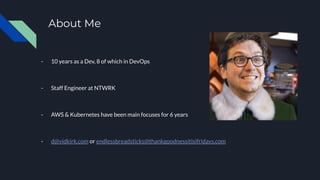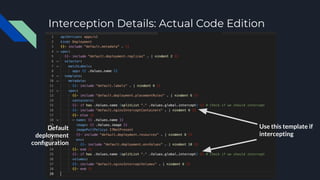David Kirk_Local Microservice Development in EKS.pdf
- 1. Local Microservice Development in EKS David Kirk
- 2. About Me - 10 years as a Dev, 8 of which in DevOps - Staff Engineer at NTWRK - AWS & Kubernetes have been main focuses for 6 years - [email protected] or [email protected]
- 3. What’re we talkin’ about? - Describe the problem - how do we develop against EKS? - Attempted & Potential Solutions - Hybrid Environments - the solution we’re using at NTWRK - Case-study of how it’s implemented at NTWRK - Suggestions of quick wins w/ this technique
- 4. I’ve done a talk like this before - I’ve learned lessons since then about how to do this better - That talk proposed something that took 6+ months to fully build - The goal here is to describe the solution and give practical wins you can bring home
- 5. The Problem - Developing against EKS - Most development happens locally - Tools are designed with this in mind - Debuggers, profilers, build tools, etc - Developers are used to this mental framework - EKS is not running locally - But it’s where production is running - How do we bridge this gap? - Ideal solution is one that allows us to use EKS and local tools
- 6. Why is this worth solving? - Reduce cognitive overhead - There’s a barrier to entry here - Worth it in the long run - fewer variations to consider - Minimize internal tooling & configuration complexity - The fewer environmental variations, the less work to align them - Devs get Ops experience - Hey look, it’s DevOps! - If devs gain k8s experience while dev-ing, they know better how to work with k8s in prod
- 7. Summary of Goals - Easy to use & implement - Useful - Devs can tie their local machine into EKS - Ideally vice-versa as well
- 8. High Level Solution - Redirect Traffic to Local - This is the basis for all proposed solutions - Run the thing you’re developing locally - Run everything else somewhere else - Send traffic that would go to the thing you’re developing to localhost Everything Else Runs Here Your Laptop Service A Service B Dummy Service C Actual Service C - Dummy service replaces yours in the cluster - Receives traffic like normal - Routes all traffic to your localhost Network Traffic
- 9. Potential Solution: docker-compose - Pro: Simple to configure - It’s entry-level deployment yaml, IMO - Very readable, and in one file - Con: It’s not kubernetes - Duplicating configuration - effort to maintain - Devs aren’t exposed to kubernetes - Run everything not being actively developed in docker-compose - Substitute the thing you’re developing w/ an nginx container - Forward all traffic it gets to `host.docker.internal` - Run the thing you’re developing locally
- 10. Potential Solution: Minikube - Pro: It’s kubernetes! - You get some kubernetes experience - But also you don’t get multi-node kubernetes - Con: Configuration complexity - All of your charts/definitions need to support both minikube & EKS - That’s gonna be some complex charts - Run everything not being actively developed in Minikube - Substitute the thing you’re developing w/ an nginx container - Redirect its traffic to `host.minikube.internal` - Run the thing you’re developing locally
- 11. Running Everything Locally Has Limits - Things will get slow - You’re better at creating stuff for your CPU to do than Intel & Apple are at making CPUs that can do stuff fast - Even beefy machines will slow down - This slows down everything else around development - You can deploy subsets of services - Again introducing configuration complexity - Hard to maintain, prone to issues
- 12. Proposed Solution - Hybrid EKS Development - Run everything in EKS except what you’re developing - Substitute the thing you’re developing w/ an nginx container - Forward all traffic it gets to your IP address - Run the thing you’re developing locally - Use a VPN to access the cluster - Reach into cluster w/ it - use k8s DNS for your cluster’s CIDR - Reach out of the cluster w/ it - use VPN IP addresses to talk to dev machines
- 13. Exclusion & Interception - Two modes of network traffic interaction - These cover all of the use cases we’ve seen internally - Exclusion - Scale the deployment you’re developing to 0 - Run it locally, and use k8s DNS through the VPN to interact w/ cluster - Used if it doesn’t receive requests - e.g. Kafka Consumers & Cronjobs - Interception - Replace the pod you’re developing w/ nginx - Redirect that traffic to your laptop’s VPN IP address - Run it locally, again use k8s DNS through the VPN
- 14. Exclusion & Interception Examples EKS Cluster Your Laptop Kafka Broker Service A Service B nginx Service C Actual Service C Network Traffic over VPN Consumer D - Exclude D - It doesn’t receive requests - it consumes from Kafka - Intercept C - Capture requests & send to local machine
- 15. Case Study: Using this at NTWRK - We have “personal environments” - Single centralized helm repo defines everything that’s deployed - `make build-dev` builds all containers - `make deploy-dev` takes helm and deploys it into personal namespace - Intercept & Exclude at deploy time - `make deploy-dev-tailscale INTERCEPT=[chart_name]` - `make deploy-dev-tailscale EXCLUDE=[chart_name]` - Can intercept & exclude in one deployment
- 16. Interception Details - How do we route that traffic to the VPN IP address? - We use Tailscale as our VPN - All examples will reference those specifics, but concepts can be tweaked based upon your needs - Replace containers in intercepted pod - nginx routes traffic to VPN IP address - set at deploy time - Tailscale side car gives nginx access to VPN over pod’s localhost
- 17. Interception Details: Actual Code Edition Use this template if intercepting Default deployment configuration
- 18. Interception Details: Actual Code Edition pt 2 Internal Traffic External Traffic Send it to local machine’s VPN IP
- 19. Interception Details: Actual Code Edition pt 3 nginx container nginx configuration Tailscale sidecar grants VPN access
- 20. Potential Quick Wins - You don’t need personal environments - Run command locally to intercept static environment - Could be staging or UAT - Be careful about collisions - Team-specific long-lived environments - Less concern about collisions















![Case Study: Using this at NTWRK
- We have “personal environments”
- Single centralized helm repo defines everything that’s deployed
- `make build-dev` builds all containers
- `make deploy-dev` takes helm and deploys it into personal namespace
- Intercept & Exclude at deploy time
- `make deploy-dev-tailscale INTERCEPT=[chart_name]`
- `make deploy-dev-tailscale EXCLUDE=[chart_name]`
- Can intercept & exclude in one deployment](https://image.slidesharecdn.com/davidkirklocalmicroservicedevelopmentineks-230614011628-bc0c7658/85/David-Kirk_Local-Microservice-Development-in-EKS-pdf-15-320.jpg)





